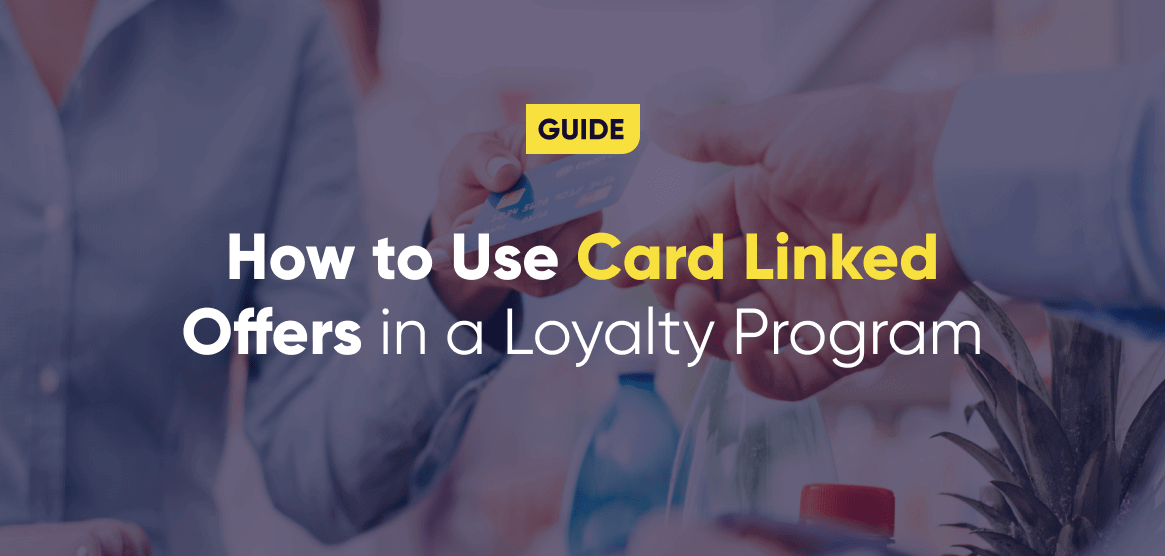In this article, we will be investigating how card linking technology and card linked offers have evolved in certain consumer markets and how they can be used as an innovation for the loyalty industry.
In short, card linking is a technology solution where individual transactions are tracked via a customer’s 16-digit card number. Card linking has grown in popularity over the last decade and is most prevalently used by retail banks, but there are also powerful applications in retail, travel, and hospitality, thanks to the appearance of card linked offers.
Table of Contents
What Is Card Linking?
Tracking a customer’s transactions via their payment cards has major advantages in terms of collecting every card transaction a customer makes. The process is seamless for the customer: once they have registered their card, they’ll become eligible for bonus points or cashback offers. Customers can also register multiple cards in most programs.
However, it does require significant data security measures for obvious reasons. It also relies on customer permissions to track their transactions, which makes some customers nervous. For this reason card linking remains most prevalent in the retail banking sector, where the bank has access to transactional information. Cardlytics has been the main driving force in this sector, creating programs with retail banks around the world, but now there are a number of businesses innovating in this space.
How Can Card Linking Enhance Loyalty Programs?
Card linking technology has a number of advantages for the loyalty industry. Firstly, this process eliminates the need for a separate loyalty card to identify the customer since the customer is identified by their card transaction. This means that no card transaction is ever missed and the solution is very well suited to an omnichannel engagement. This produces a frictionless journey for the customer, where many different behaviors and interactions can be collected and analyzed.
If a brand is also able to match the customers’ transaction to basket items, they can build a picture of the customer’s specific shopping behaviors, providing an extremely granular understanding of the customer.
All of these data points allow the brand to understand a greater breadth of behaviors and specific customer likes and needs, which, in turn, enables highly targeted and personalized communications. This presents an opportunity to create stronger engagement, advocacy, and loyalty.
To learn more about the process of building a successful loyalty program, download our comprehensive ebook.
Does Card Linking Work for Any Industry’s Loyalty Program?
In short, yes. This is a relatively new marketing tool, which could enhance any loyalty program. Brands should see card linking as an opportunity to drive a more targeted and more profitable approach to customer communication and offers.
Card linking enables a frictionless journey for the customer, real-time communications, and highly targeted and personalized communication.
The data collected through card linking allows for offers to be served in a very precise way: to the right customer, at the right time, and through the right channel, based on their previous behaviors.
Another significant advantage for retail programs is that e-receipts can be automatically sent, where the customer matches their email address to their payment cards.
There will be more activity in this space as brands start to build out their personalization and targeting capabilities. What it really highlights is the need for brands to re-appraise their loyalty propositions, to re-set, evolve, and adapt to capabilities that are already in existence. And most importantly, it highlights customer expectations of how brands will use these digital progressions to enhance their shopping experience.
What Are Card Linked Offers?
A card linked offer is the process of providing customers with targeted offers based on their purchase behavior. In other words, businesses can essentially use a customer’s card transactions to understand their likes, needs, hobbies, and favorite merchants.
The way in which customers receive offers is changing significantly, with card linked offers becoming a more prevalent benefit ever since the significant changes in the law to interchange rates in 2015, which has impacting card issuers’ profits dramatically. Retail banks can use this new service to engage their merchants and generate a new revenue stream.
Merchants can use this service from the card issuers to target customers with highly personalized offers based on their purchase habits. Merchants can very effectively drive frequency and value, as well as acquire customers who they know are active in the sector. Geolocation and time-of-day targeting are also available and, crucially, this mechanic supports omnichannel behavior.
But it’s really only now starting to become a part of the broader loyalty benefit tool kit outside of the retail banking sector.
How to Deliver Card Linked Offers
These merchant-funded offers are starting to gain traction in the banking, retail, and marketing world as a clear future directive of promotional strategies…but only where an aggregator or retail bank manages the program.
To deliver successful card linked offers, three elements need to be in place:
- Cardholders who want card linked offers
- Merchants who want to provide and pay for the card linked offers
- Usable transaction data to match and merge the cardholder and merchant transaction
How Can Card Linked Offers Boost Your Loyalty Program?
With more and more alternatives to traditional Earn & Burn programs cropping up, it’s time to think outside the box and provide richer, more targeted offers in your loyalty offering.
Merchants can utilize card linked offers to reach customers in a very targeted way and understand their purchase habits so that frequency and value can be increased. Merchants can also very quickly identify lapsing behavior and competitor steal.
The benefits of adding card linking to loyalty offerings include the following:
- You can create a seamless payment experience, as the payment card becomes your loyalty card. This creates a frictionless and real-time engagement for the customer and saves on the cost of loyalty card production and replacement.
- You can gather rich, granular transactional data, both on and offline, and gain a better understanding of your customers’ shopping behaviors.
- Card linked offers within a loyalty program provide more flexibility for the customer. Claimed coupons can be automatically applied to the card and the total value of the customers’ loyalty can be shown over time.
How Can You Get Involved?
So, let us leave you with this to mull over: how can you incorporate card linked offers into your program?
Start thinking outside of the box as new innovations arrive on the scene to help bridge the gap between loyalty and card linking. Brands such as Swapi plan to drive this connection between the two and shake up how the world sees loyalty. Members can add all their loyalty cards to the digital wallet and collect Swapi points via their payment card, to redeem for offers in the Swapi marketplace, easing loyalty point liability in the process.
Find the Best Solution for the Future
The future is all about richer links between brands and customers, and we predict that card linking will be part of that journey. Card linking and card linked offers can help to improve the customer experience and help the brand understand their customers better.
Curious about other technical capabilities of a sophisticated, next-gen loyalty program? Feel free to include us in your RFP, or get in touch with us by booking a demo.
If you wish to learn more about popular customer retention tools, download our ebook about gamification.
Tom is a highly acclaimed loyalty expert and commercial leader, the Managing Director at The Loyalty People. He has over 15 years’ experience across a wide range of sectors, including financial services, retail, food and beverage, travel and FMCG. Tom’s experience covers the latest trends in loyalty including paid-for loyalty, card-linking, real-time data analytics and emotional / experiential loyalty techniques

